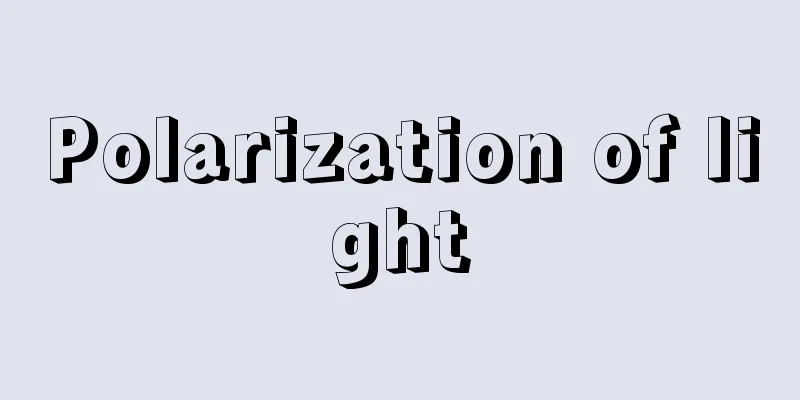Polarization of light

|
The state in which light waves vibrate in a regular direction. Light is a type of electromagnetic wave, and in a uniform medium, the vibration directions of the electric field and magnetic field and the propagation direction are all perpendicular to each other as transverse waves. [Tanaka Shunichi] Polarization Classification As shown in , linearly polarized light is light in which the electric field E (and therefore the magnetic field H ) oscillates sinusoidally in a plane that includes the direction of propagation ( z axis) ( E is in the xz plane, H is in the yz plane). For this reason, it is also called plane polarized light. The oscillation of E can be expressed as In contrast, light whose vibration direction changes irregularly from moment to moment, but whose directional distribution is uniform in all directions when the average is taken over a certain period of time, is called natural light, and light that is considered to be a combination of natural light and polarized light is called partially polarized light. In contrast to partially polarized light, pure polarized light (elliptically, circularly, linearly polarized light) is sometimes called completely polarized light. [Tanaka Shunichi] Applications of Polarized LightLight emitted from a normal light source is approximately considered to be natural light. Scattered light when natural light is scattered by particles or groups of particles, and light reflected or transmitted through the surface of a non-absorbing medium such as glass, generally become partially polarized. In 1808, the Frenchman Malus first discovered polarization in light reflected from a glass surface. In particular, when the angle of incidence satisfies Brewster's law, the reflected light becomes linearly polarized. A polarizer is an element that converts natural light into polarized light. Examples are a Nicol prism and a polarizing plate, but some polarizers use reflection or transmission on the surface of a non-absorbing medium. Polarizers are also used to examine the polarization state of light, in which case they are called analyzers. A polarizer and analyzer arranged as shown in is called a polarimeter (sometimes called a polariscope), and is used to examine the change in polarization caused by a sample, usually by rotating the analyzer around the optical axis, to clarify the physical properties of the sample. A polarimeter is a device used to measure the concentration of sugar solutions. examines the change in linearly polarized light, but some also measure elliptically polarized light. The human eye, whose retina is made of materials with anisotropic refractive index and absorptivity, acts as a kind of analyzer and can perceive the vibration direction of the electric field of the incident light. That is, when you stare at a linearly polarized white field, you see a yellow, slightly dark hourglass-shaped pattern that stretches perpendicular to the vibration direction of the electric field, as shown in , A, and has a size of 2 to 4 degrees in visual angle and a bluish area around it. This is called a Heidinger brush after its discoverer, but if the vibration direction of the incident polarized light is fixed, it will soon become invisible. Each ommatidia that make up the compound eye of a honeybee can also distinguish the direction of incident polarized light, and it is said that the direction of the sun (sunlight is polarized due to scattering by fine particles in the atmosphere) can be detected in visual angle with an accuracy of 1 to 5 degrees from the difference in the direction of polarization incident on each ommatidia. [Tanaka Shunichi] "Optical Technology Series 4: Polarization and Crystal Chemistry" by Yasuhiro Doi (1975, Kyoritsu Shuppan) [Reference] | | | |At any point in space , Linearly polarized light (Figure A) At any point in space, and the combination of these ©Shogakukan Rotary polarization (Figure B) ©Shogakukan "> Polarimeter (Fig. C) ©Shogakukan "> Haidinger Brush (Fig. D) Source: Shogakukan Encyclopedia Nipponica About Encyclopedia Nipponica Information | Legend |
|
光波の振動方向が規則的なものおよびその状態。光は電磁波の一種で、一様な媒質中ではその電界・磁界の振動方向、伝搬方向の三つが互いに垂直な横波である。 [田中俊一] 偏光の分類直線偏光はのように電界E(したがって磁界Hも)が伝搬方向(z軸)を含む面内(Eはxz面内、Hはyz面内)に正弦波状に振動している光で、このため平面偏光ともよばれる。Eの振動を式で表せば これに対して、刻々に見れば振動方向が不規則な変化をしているが、ある時間の平均をとったときには、方向分布があらゆる方向に一様である光を自然光といい、自然光と偏光が合成されたとみなされる光を部分偏光という。部分偏光に対して、純粋な偏光(楕円、円、直線偏光)を完全偏光ということもある。 [田中俊一] 偏光の応用普通の光源から出る光は近似的に自然光とみなされる。自然光が粒子や粒子群で散乱されるときの散乱光や、ガラスなどの非吸収性媒質の表面で反射や透過をする光は一般に部分偏光になる。1808年フランスのマリュスはガラス面からの反射光についてはじめて偏光を発見した。とくにブルースターの法則を満足する入射角のときには、反射光は直線偏光になる。 自然光を偏光に変える素子を偏光子polarizer(または偏光器)といい、ニコルのプリズムや偏光板がその例であるが、非吸収性媒質表面での反射や透過を利用するものもある。偏光子はまた光の偏光状態を調べるのにも用いられ、この場合はとくに検光子analyserという。偏光子、検光子をのように配置したものは偏光計polarimeter(偏光器ということもある)とよばれ、試料による偏光の変化を、普通、検光子を光軸の周りに回転して調べ、試料の物理的性質を明らかにするのに用いられる。とくに砂糖溶液の濃度を測定するために用いられるものを検糖計という。は直線偏光の変化を調べるものであるが、楕円偏光の測定を行うものもある。 人間の目は、網膜が屈折率や吸収率の異方性をもつ物質で構成されているので一種の検光子の働きをし、入射する光の電界の振動方向を知覚することができる。すなわち、直線偏光の白色視野を注視すると、のAのように電界の振動方向に垂直に伸びる黄色でやや暗い砂時計状の模様が見え、その大きさは視角で2~4度、また周りに青みを帯びた部分がある。これは発見者の名前をとってその形状からハイディンガー・ブラシとよばれているが、入射する偏光の振動方向を固定すると、じきに見えなくなってしまう。ミツバチの複眼を構成する各個眼も入射偏光方位を識別でき、それぞれの個眼に入射する偏光方位の相違から、太陽の方向(大気中の微粒子の散乱によって太陽光は偏光している)を視角にして精度1~5度で検知できるといわれている。 [田中俊一] 『土井康弘著『光学技術シリーズ4・偏光と結晶化学』(1975・共立出版)』 [参照項目] | | | |空間の任意の点での、©Shogakukan"> 直線偏光〔図A〕 空間の任意の点での、と、これらを合成した©Shogakukan"> 回転偏光〔図B〕 ©Shogakukan"> 偏光計〔図C〕 ©Shogakukan"> ハイディンガー・ブラシ〔図D〕 出典 小学館 日本大百科全書(ニッポニカ)日本大百科全書(ニッポニカ)について 情報 | 凡例 |
Recommend
Kan'ei-ji Temple five-story pagoda
…From 1632 (Kan'ei 9), he served as the chief...
"Princess Ito's Prayer"
It is said that he was particularly skilled in cl...
Merchant bank
A financial institution active in London's lon...
Jinpu - Jinpu
A laborer who transported food and other supplies ...
Herring
...A migratory fish of the polar zone (illustrati...
Toranomon Incident - Toranomon Incident
On the morning of December 27, 1923, Prince Regent...
Lugard, Frederick John Dealtry, 1st Baron Lugard
Born: January 22, 1858, Madras [Died] April 11, 19...
Patríci (English spelling)
A Roman aristocracy of lineage. The name comes fro...
Occitan Research Institute - Occitan Research Institute
...The term Occitan did not catch on easily, and ...
Feuillet, RA (English spelling) FeuilletRA
…Not to mention lyrics and musical scores, dance ...
Udumbara
...Udumbara flower. "Udon" is an abbrev...
Clapham Sect
…However, he himself was originally opposed to th...
Baudot, JME (English spelling) BaudotJME
…The printing telegraph itself was invented in 18...
Phillips, AB (English spelling) PhillipsAB
...a curve that shows a negative correlation betw...
Fixed cost, variable cost
The costs required to produce goods and services c...









